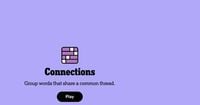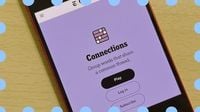On September 13, 2025, puzzle enthusiasts around the globe woke up to the latest challenge from The New York Times: Connections puzzle #825. As the clock struck midnight in each time zone, the daily ritual began anew—players logging in, coffee in hand, ready to tackle the grid of 16 words and tease out the hidden threads that link them together. For some, it’s a way to jumpstart the day; for others, a battle of wits to be savored during a lunch break or commute. But for everyone, it’s a test of logic, pattern recognition, and maybe a little bit of luck.
Connections, which debuted in June 2023, has quickly become a staple in the New York Times Games lineup. Its premise is simple, but the execution can be devilishly tricky. Each day, players are presented with a fresh set of 16 seemingly unrelated words. Their mission? To sort these words into four groups of four, each group connected by a common theme. There’s a twist: some words have double meanings, and the connections aren’t always obvious. The groups are color-coded—yellow for the easiest, followed by green, blue, and finally purple, the most challenging.
According to Insider Gaming, the four groups for September 13, 2025, carried the following hints: Yellow—think diaries, confessions, or locked drawers; Green—if it’s not minor, it’s probably one of these; Blue—you’ve probably seen them in exchange rate tables; and Purple—one’s a Wild West legend, one jingles, one marches, one flies. The words up for sorting were: NICKEL, KEY, WON, MAJOR, PRINCIPAL, DOLLAR, PRIVATE, BILL, SOLDIER, PERSONAL, CRITICAL, POUND, INNER, WING, STIRLING, and SECRET.
For those who prefer a nudge rather than a full reveal, Parade offered category-level hints: "Of utmost…", "Moves in silence.", "For the Love of Money by The O’Jays.", and "A popular Bob Marley song." These cryptic clues aimed to spark connections without spoiling the fun. But for players who’d hit a wall, the answers were just a scroll away.
So, how did the puzzle break down? The yellow group, labeled "Important," consisted of CRITICAL, KEY, MAJOR, and PRINCIPAL. As CNET pointed out, these words all relate to significance or importance—if something is critical or key, it’s vital; if it’s major or principal, it’s central or primary. Simple enough, right?
The green group, "Intimate and undisclosed," brought together INNER, PERSONAL, PRIVATE, and SECRET. These words evoke the world of hidden thoughts, private diaries, and whispered confidences. As Insider Gaming noted, the yellow group’s hint—“Think diaries, confessions, or locked drawers”—pointed directly to these words, all of which suggest something kept away from public view.
Next up was the blue group, themed "Global currencies." Here, DOLLAR, POUND, STIRLING, and WON made the cut. If you’ve ever glanced at a currency exchange board, these names are instantly familiar: the Dollar (used in the United States and elsewhere), the Pound (the UK’s currency), the Won (South Korea), and Sterling (another name for the British currency). As Parade succinctly put it, these are “money around the world.”
The final, and often most perplexing, group was purple: "Buffalo ___." This one stumped many players, as it required not just knowledge but a bit of lateral thinking. The answers—BILL, NICKEL, SOLDIER, and WING—are all words that can be paired with “Buffalo” to create common phrases or names. Buffalo Bill was a legendary Wild West figure; Buffalo nickel is a famous U.S. coin; Buffalo Soldier refers to African American soldiers in the post-Civil War era; and Buffalo wing is the spicy snack beloved in bars across America. As CNET remarked, this group was “sometimes bizarre,” but ultimately satisfying once the connection clicked.
The puzzle’s difficulty, according to The New York Times itself, was rated 2.8 out of 5 by its testers—challenging, but not insurmountable. Some players found the groups straightforward, while others admitted to stumbling, especially over the purple group. One writer at CNET confessed, “I knew money/currency was one of the groups today, but I guessed it wrong the first time. I originally had dollar, pound, nickel and bill grouped together. Otherwise, this wasn’t too bad to solve, though I’m not sure I would’ve figured out the purple group.”
For newcomers, Connections offers a brief but potent lesson in humility. Four guesses are all you get each day, and if you use them up without cracking all the groups, it’s game over until the next reset at midnight local time. The game’s design encourages both careful analysis and a willingness to walk away and return with fresh eyes. As one player advised, “If you’re stuck, shuffle the board. You can shuffle as many times as you’d like to help you see some different word combinations.” Others recommended focusing on the yellow group first, since those words typically have the most obvious connections.
The game’s popularity has also spawned a vibrant online community. Players swap hints, share their solve grids, and commiserate over tricky puzzles. The New York Times even launched a Connections Bot, allowing registered players to track their progress, analyze their performance, and compare win streaks. The social aspect adds a layer of camaraderie—and, let’s be honest, a little friendly competition—to the solitary act of puzzling.
For those who crave even more wordplay, Connections is just one of several daily games offered by The New York Times. Wordle, the Mini Crossword, and the newer Strands puzzle all provide a daily dose of brain exercise. But Connections stands out for its blend of logic, vocabulary, and lateral thinking. As Insider Gaming put it, “Playing NYT Connections on your commute or while waiting for a coffee is a fantastic way to kill a few minutes.”
So, how did you fare on puzzle #825? Did you breeze through the groups, or did the purple category leave you scratching your head? However you did, rest assured: the next challenge is just hours away. When midnight strikes, a new grid will appear, ready to test your wits—and maybe teach you a thing or two about the curious ways words connect.







